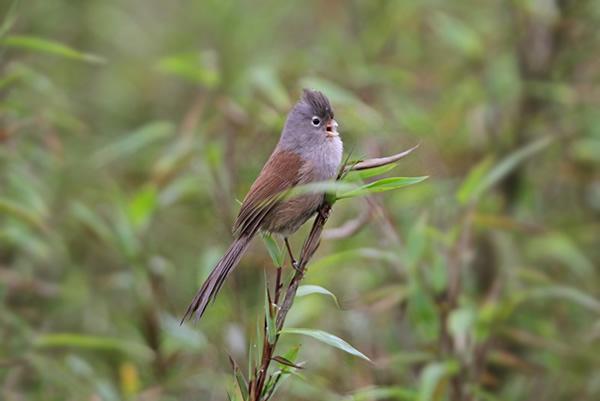Sinosuthora zappeyi
IUCN
LCBasic Information
Scientific classification
- name:Sinosuthora zappeyi
- Scientific Name:Sinosuthora zappeyi,Grey-hooded Parrotbill,Paradoxornis zappeyi
- Outline:Songbird
- Family:Passeriformes Oriole Parus
Vital signs
- length:12-13cm
- Weight:8-11g
- lifetime:No verification information
Feature
The beak is short, thick, and yellow, like a parrot's beak. The top of the head has a short, dark gray crest and white eye circles.
Distribution and Habitat
The Dusky Parrotbill is a bird endemic to China, and is only distributed in Sichuan (Mt. Emei in the middle, Luding and Erlang in the west, Ebian and Ganluo in the southwest), Guizhou (Weining and Hezhang in the northwest), and Yunnan (Dashanbao in the west of Zhaotong City).
The Dusky Parrotbill mainly inhabits bamboo bushes and shrubs in high mountains and plateaus at an altitude of 2,300-3,200 meters, especially in shrubs and tall grasses along open lakes and streams.
Appearance
Male and female plumage is similar. The forehead, top of the head, crest, nape, nape and back of the neck are dark grey with fine dark feather stems. The upper back is slightly lighter grey, the sides of the head and neck are also grey but slightly lighter than the grey on the top of the head; the front of the eyes is dark grey, the cheeks and ear feathers are grey, and the eye circles are very eye-catching. The surface of the middle back, lower back, shoulders and wings is brown or reddish brown, the waist and upper tail coverts are greyish yellow brown, the tail is greyish brown or dark brown, and the feather edges are olive brown. The flight feathers are brown or dark brown, the outer feather edges are brown, and the inner feather edges of the secondary flight feathers are yellowish white. The chin, throat, and chest are light grey or grey, sometimes slightly stained with rose red, and the abdomen, flanks and lower tail coverts are light brown or light reddish brown.
The iris is
Details
Grey-hooded Parrotbill is a small bird of the Parrotbill family and Parrotbill genus. It has two subspecies.

The main difference between the two subspecies of the Dusky Hatchling is that the nominate subspecies has dark gray from the top of the head to the nape, a dark brown back, and darker plumage; while the Erlangshan subspecies has earthy gray from the top of the head to the nape, a light brown back, and lighter plumage.
The Dusky Hatchling is a resident bird. Except for the breeding season, it is active in pairs or alone, and in other seasons, it is mostly in groups. It often jumps or flies between branches of bushes, but does not fly far, only short-distance low-altitude flights between bushes. It often calls while flying, and the call is three times a second, which sounds like "hush, hush, hush". It mainly feeds on insects, and also eats plant fruits and seeds.
Based on an assessment of known records, abundance and range size, it is estimated that there are 2500-9999 mature individuals of the Dusky Shrub. This is consistent with the estimated population density of similar conspecifics or close relatives, which is equivalent to 3750-14999 individuals.
The main threat facing the Dusky Shrub is likely to be forest loss and fragmentation, although it is not clear how much habitat loss is in high altitude areas. Since the late 1960s, forest cover in Sichuan has declined rapidly due to logging, reclamation and grazing. The periodic flowering and death of bamboo, combined with forest fragmentation, may affect the species. In Mount Emei, the construction of a railway for tourism in 1998 occupied part of its habitat, which may also have led to disturbance of its habitat as the number of tourists going to the summit increased. The promotion of tourism also led to the construction of a ski resort in Mount Wawu, Sichuan, which has attracted about 300,000 tourists per year (Yingxin et al., 2009). This has led to the destruction of bamboo habitat and increasing disturbance (S. Francis in litt. 2016).
Many protected areas established for giant pandas (Ailuropoda melanoleuca) have suitable habitats for the Dusky Parrotbill, but little is known about its distribution and abundance. The protected areas that have been established include: Emeishan Nature Reserve, Mabian Dafengding Nature Reserve, Meigu Dafengding National Nature Reserve (Sichuan) and Guizhou Caohai National Nature Reserve.
In September 2010, the bird group of the Kunming Institute of Zoology, Chinese Academy of Sciences, and the Dashanbao National Nature Reserve Administration conducted a joint survey and unexpectedly discovered a bird unique to China, the Dusky Parrotbill, in Dashanbao, west of Zhaotong City, Yunnan Province. This is the first time that the Dusky Parrotbill has been recorded in Yunnan Province.
Listed in the IUCN Red List of Threatened Species (IUCN 2016 ver 3.1) - Vulnerable (VU).
It has been listed in the World Endangered Bird List.
Listed in the List of Terrestrial Wildlife with Important Economic and Scientific Research Values under State Protection issued by the State Forestry Administration of China on August 1, 2000.
Listed in the second level of the List of National Key Protected Wildlife in China.
Protect wild animals and stop eating game.
Maintaining ecological balance is everyone's responsibility!








